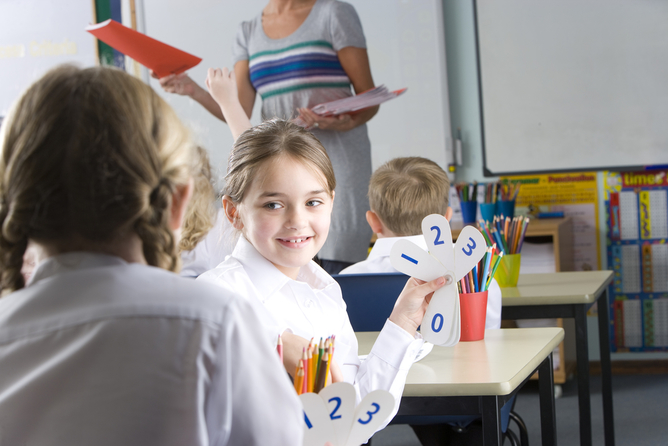
Justin Dillon, Professor of Science and Environmental Education, Head of Graduate School of Education
Ed Miliband’s pledge that Labour, if elected, would limit school classes for five, six and seven-year-olds to 30 pupils reignites a core question about how best to spend money to improve education.
In making this a plank of Labour’s emerging manifesto, Miliband blames the coalition government and, in particular, the former education secretary Michael Gove, for a trebling of the number of primary pupils in classes with more than 30 children from 31,265 in 2010 to 93,345 in 2014.
Labour’s policy – which echoes a pledge by Tony Blair in 1997 – might appeal to parents and teachers, but it is also backed by evidence that smaller class sizes do help push up attainment in the first years of primary school.
The average size of a class taught by one teacher on the census day in January 2014 was 27.4. Overall in England, there are more than 58,000 Key Stage 1 classes (pupils aged five to seven) of which almost 3,000 had at least 31 pupils in them about 12 months ago. So, although the number of students in classes with more than 30 children has trebled, we’re still only talking about one in 20 classes across the country.
One of the reasons why class sizes have risen is that there are more primary-aged children now. Since 2010, the number of Key Stage 1 pupils has risen by 11.2%, but the number of classes has only grown by 8.1%. The coalition government changed the rules on admissions – meaning, for example, that schools have to accept pupils whose parents are in the armed forces or who move into an area where there are no surplus places.
Small is best
There is a growing body of research on how much class size matters to children’s attainment. Peter Blatchford, a researcher at the UCL Institute of Education, notes that the issue comes round regularly, with the debate frequently intense and sometimes angry. One reason that some parents send their children to private schools is because they have smaller classes resulting in more individualised teaching and a better working environment – or so the argument goes.
When asked, teachers usually say that large class sizes are counter-productive. There’s something about class size that makes it a controversial topic in other countries, too. Politicians in China, Japan, the Netherlands, Singapore, South Korea and the USA have brought in policies aimed at reducing class sizes. When New Labour enacted Blair’s promise after the 1997 election, the Scottish government went one step further and set a maximum class size of 25.
The evidence is clear but, perhaps, surprising. In the US, a team of researchers randomly allocated pupils and teachers to one of three types of class within the same school. The three models were: “small” classes, which had 13-17 pupils; “regular” classes (22-25 pupils) with just one teacher; and “regular” classes which had a teacher and a full-time teaching assistant.
The project involved more than 7,000 pupils in nearly 80 schools. The pupils were followed through four years of schooling, from kindergarten (aged five) to third grade (aged eight). Pupils in small classes performed significantly better than pupils in regular classes and gains were still evident after grade 4, when pupils returned to normal class sizes.
Primary kids benefit most
In England, Blatchford directed the Class Size and Pupil Adult Ratio project which, instead of setting up an experiment, simply studied what went on in normal classrooms. Blatchford and his team followed more than 10,000 pupils in more than 300 schools. The pupils were tracked from when they entered school aged four to five-years-old, until the end of primary school, aged 11.
Class size made a difference – children did better in smaller classes in both numeracy and literacy during their first year in school. The effect was greater for the pupils who started school with lower attainment. At the end of the second year in school, the effect was still evident in literacy attainment but not numeracy. Yet by the end of the third year the effects were far less evident in either numeracy or literacy. So, the evidence suggests that smaller classes benefit pupils in their first years in primary school but the effect seems to disappear as students get older.
Yet while there is evidence that in the first years in primary school, the smaller the class size, the better. There is no clear evidence supporting an optimal class size, be it 20, 25 or 30.
Impact of teaching assistants
Other research has tried to unpick what impact other adults, such as teaching assistants, have on pupil attainment. The evidence is that in classes where there are teaching assistants, students, in general, do less well even when you take into account reasons why the assistants are there in the first place.
One reason for this counter-intuitive finding may be that teaching assistants are often employed to work with students who are under-attaining, when actually it is the classroom teacher who is probably more able to bring out the best in such pupils. The study’s findings led other researchers to find ways to involve teaching assistants more effectively in schools.
More research is needed into what actually happens in classrooms of differing sizes. We still don’t know enough about the impact of class size on pupil attitudes, motivation and self-belief. What we do know is that in larger classes, lower attaining students are more likely to be off-task. What is needed is a study into which teaching practices work best in smaller and larger classes. Improving teaching might have more impact than simply reducing class sizes.
This blog was first posted by The Conversation on 16th February 2015.


Two observations:
1. Capping class size can have a massive impact on a school’s finances. If you have 33 children in a year group you get funding for each of them – but that won’t be enough to employ two teachers. An option for a school is to split the year group. So if the next year group has only 26 pupils you combine the years and split them into two classes both below 30. Trouble is if every year group has just over 30 the maths doesn’t work. Ultimately you have to create another class and employ another teacher and TA – and hope the income is sufficient.
2. My wife has taught in a class of 45 KS2 children. The significant thing was that they had two teachers in one classroom. One was full time, my wife was 3 days/wk. They were able to focus on the needs of small groups of children and overall really good progress was made. However this was only possible because the school used its pupil premium money for the purpose – something that couldn’t be repeated the following year.
In both cases, money is the key issue. Without it the capping of class sizes is an exercise in delegating an impossible task.